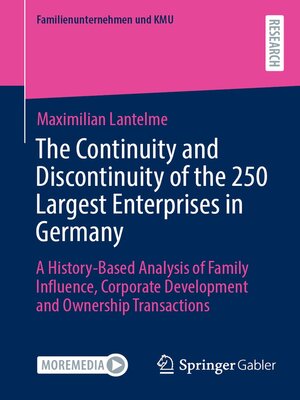The Continuity and Discontinuity of the 250 Largest Enterprises in Germany
ebook ∣ A History-Based Analysis of Family Influence, Corporate Development and Ownership Transactions · Familienunternehmen und KMU
By Maximilian Lantelme

Sign up to save your library
With an OverDrive account, you can save your favorite libraries for at-a-glance information about availability. Find out more about OverDrive accounts.
Find this title in Libby, the library reading app by OverDrive.



Search for a digital library with this title
Title found at these libraries:
| Library Name | Distance |
|---|---|
| Loading... |
This book studies the long-term development of the 250 largest family and non-family enterprises in Germany between 1958 and 2018. In particular, the continuities and discontinuities of the companies' ownership structure, operations and solvency are examined. Historical methods are used to advance the understanding of the attributed long-term orientation of family firms in family business research. The collected data of the 250 largest enterprises of 1958 provide the most comprehensive historical overview of the industrial landscape of this period. The long-term analyses show that more than half of the companies fail and less than a quarter keeps their ownership structure in the observation period of 60 years. In this timeframe, family-owned businesses have relatively stable ownership structures and superior survival rates compared to public companies although the latter experience higher growth rates. A listing of a family firm leads to the discontinuity of the family's majority ownership in the mid- to long-term. Furthermore, company types like foundation-owned enterprises and foreign subsidiaries show even higher survival rates. The book closes with practical implications based on the identified development patterns of the surviving and failed enterprises.







